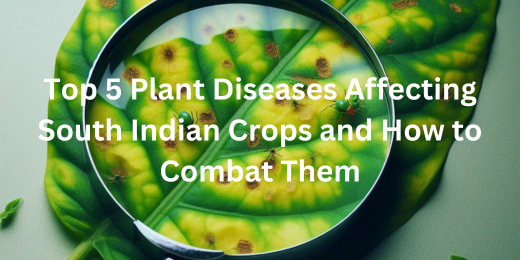
Top 5 Plant Diseases Affecting South Indian Crops and How to Combat Them
Plant diseases in South India
Introduction to Plant Diseases in South India
Plant diseases in South India pose a significant threat to agriculture, impacting both crop yield and food security. Addressing these diseases is crucial for maintaining agricultural productivity and ensuring a stable food supply for the region. Effective management strategies are essential to mitigate the adverse effects on crops and farmers.
South Indian crop diseases have a profound impact on the region’s agriculture, causing severe losses and economic challenges. Understanding these diseases is vital for developing targeted solutions and improving crop resilience. The blog aims to highlight common plant diseases and provide practical advice for managing them effectively.
The objective of this blog is to identify prevalent plant diseases and offer actionable solutions for their management. By focusing on both the problems and potential remedies, readers can better protect their crops and enhance agricultural outcomes. This approach is essential for sustaining agricultural practices in South India.
Bacterial Blight in Rice
Plant diseases in South India include bacterial blight in rice, which is characterised by water-soaked lesions and leaf yellowing. These symptoms can severely affect rice yields if not managed properly. Identifying and addressing the causes is crucial for maintaining healthy crops and preventing extensive damage.
The bacterium Xanthomonas oryzae causes bacterial blight, spreading rapidly through water and infected plant material. For control techniques to be implemented, this pathogen must be correctly identified. Understanding its spread helps in adopting preventative measures to protect rice crops from severe infection.
Management of bacterial blight involves using resistant rice varieties, practising crop rotation, and ensuring proper irrigation. These techniques help reduce the impact of the disease and enhance crop resilience. Effective management is vital for minimising losses and sustaining rice production in affected regions.
Leaf Spot Disease in Chillies
Plant diseases in South India often include leaf spot disease in chillies, which causes distinct leaf spots and wilting. These symptoms lead to reduced fruit production and overall lower yields. Recognising and addressing these issues is essential for maintaining healthy chilli plants and ensuring a productive harvest.
Fungal pathogens such as Alternaria and Colletotrichum are the primary causes of leaf spot disease in chillies. These fungi spread rapidly, infecting plants and causing significant damage. Identifying these pathogens accurately is critical for implementing effective control measures and preventing further spread.
Managing leaf spot disease involves using fungicides, removing infected plants, and ensuring optimal plant spacing. These practices help control fungal outbreaks and improve plant health. Proper management techniques are crucial for minimising the impact of the disease on chilli production.
Powdery Mildew in Cucurbits
Plant diseases in South India frequently include powdery mildew in cucurbits, which presents as powdery white patches on leaves and stems. These visible symptoms can severely impact plant health and crop yield. Early detection and management are crucial to prevent widespread damage and ensure healthy crops.
The fungal pathogen Erysiphe cichoracearum is responsible for causing powdery mildew in cucurbits. This pathogen thrives in warm, dry conditions, spreading easily among plants. Understanding its role is important for developing effective strategies to control and manage the disease.
Effective management of powdery mildew involves applying fungicides, improving air circulation around plants, and planting resistant varieties. These strategies help reduce the incidence of the disease and improve overall plant resilience. Implementing these methods can significantly mitigate the impact of powdery mildew on cucurbit crops.
Fusarium Wilt in Bananas
Plant diseases in South India often include Fusarium wilt in bananas, marked by wilting, yellowing leaves, and stunted growth. These symptoms can cause significant damage to banana plants and reduce overall yield. Properly identifying and managing the disease is essential to maintaining healthy and productive banana crops.
Banana plants are susceptible to Fusarium wilt, a soil-borne ailment caused by the viral culprit Fusarium oxysporum. This pathogen spreads through the soil and infects plant roots, leading to severe symptoms. Understanding its role helps in developing effective management strategies to combat the disease.
Management of Fusarium wilt includes techniques such as soil sterilisation, using resistant banana cultivars, and maintaining proper field sanitation. These practices help control the spread of the pathogen and protect banana crops from severe damage. Implementing these methods is crucial for ensuring the health and productivity of banana plants.
Tropical Fruit Rot in Mangoes
Plant diseases in South India frequently include tropical fruit rot in mangoes, evident from soft spots and mould growth. These symptoms indicate the fruit is affected and can lead to significant losses. Recognising these signs early is crucial for effective management and reducing the impact on mango yields.
The fungal pathogen Colletotrichum gleosporoides causes tropical fruit rot, affecting mangoes through its spores. This pathogen thrives in warm, humid conditions and spreads rapidly. Understanding its influence is essential for implementing effective strategies to manage and prevent the disease.
Management of tropical fruit rot involves proper harvesting techniques, post-harvest treatments, and improving orchard hygiene. These preventive measures help minimise the disease’s spread and protect mango crops. Adopting these practices ensures better fruit quality and reduces losses due to rot.
For comprehensive information on organic farming practices, organic fertilisers, and high-quality organic products, visit the nearest Uyir Organic Farmers Market or explore online at www.uyironline.in and www.uyirorganic.farm.